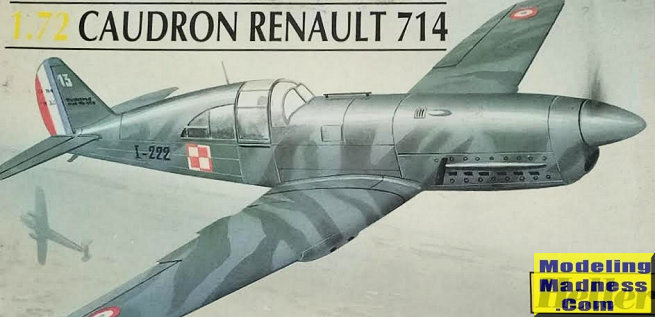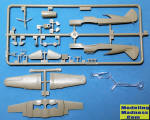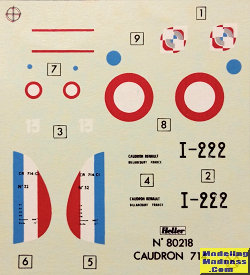Heller 1/72 Caudron C.714
|
KIT #: |
80218 |
|
PRICE: |
$3.00 on sale
|
|
DECALS: |
One option |
|
REVIEWER: |
Spiros
Pendedekas |
|
NOTES: |
|

The Caudron Renault 714, or C.714
Cyclone, was the final evolution of the C.710 series of light fighter aircraft
developed by Caudron-Renault for the French Air Force just prior to the start of
World War II. The C.714 featured a strengthened fuselage and a new wing airfoil
profile, with four 7.5 mm MAC 1934 machine guns in the wing gondolas. It was
powered by the latest version of the Renault 12R V-12 air-cooled inverted piston
engine, which could operate in negative g due to a special carburettor design.
 Heller
introduced this kit in 1967, reissuing it from time to time ever since (also
reboxed by Reflex, Centaur, SMER, ZTS Plastyk and Mistercraft through the years)
with the molds totally unchanged. My copy was the 1993 edition, discovered
(together with some other Heller/Airfix similar kits) in a small town’s book/toy
shop on my way to vacations in summer 2004, at killer prices. Needless to say I
bought them all, five in total, costing me less than a good decal sheet...
Heller
introduced this kit in 1967, reissuing it from time to time ever since (also
reboxed by Reflex, Centaur, SMER, ZTS Plastyk and Mistercraft through the years)
with the molds totally unchanged. My copy was the 1993 edition, discovered
(together with some other Heller/Airfix similar kits) in a small town’s book/toy
shop on my way to vacations in summer 2004, at killer prices. Needless to say I
bought them all, five in total, costing me less than a good decal sheet...
The
C.714 kit comes in the typical small attractive Heller top opening box, with a
very nice box art of artist Serge Jamois, portraying a C.714 having intercepted
what looks like a Do-17 at the very distant background. Upon opening the box I
was greeted with the ever so familiar Heller kit image: just 28 light gray
styrene parts, arranged in two sprues: one containing the top wing halves and
the other containing everything else.
General shapes look
correct, with the external details being, of course, raised all over. Fabric
representation is good, as is the general molding with not that much flash. A
number of ejector pin marks were spotted (some at visible areas that have to be
removed - like the ones at the exact middle of the stabilizers). The delicate
telescopic sight is molded together with one of the fuselage halves and will
most probably pose some issues during filling, sanding and painting, so you
might consider shaving it off and attach it at later stages
There’s no interior to
speak of, just an oversize rudimentary seat, not even a pilot to fill the empty
space: some beefing up will be desirable there, especially when taking into
account the relatively extensive glazing. Similarly, there are no wheel bays at
all, though the landing gear parts are sufficiently represented. The radiator
intake is merely represented as a concavity, looking unrealistic and the same
can be said for the distinctive exhausts, which are represented as protrusions.
The
canopy is quite well molded but to the thick side (the latter not necessarily
being a disadvantage, as it will distort the interior’s emptiness…).
Instructions chrome to the typical Heller b/w folded A3 size paper, containing a
short history of the type, with the construction depicted in two assembly
drawings, each (especially the first) containing a good number of
assembly/attachment actions, nothing that even the novice cannot handle, though.
Color callouts are provided where applicable, but only in Humbrol codes (meaning
having your conversion charts or your relative net application handy!).
 Only one
scheme is provided, for a I/145 Group De Chasse machine as it stood in June
1940, featuring the familiar French WWII shades, i.e. intermediate blue-gray
topsides with green and brown disruptions and lighter gray (“steel” gray)
undersides. Decals, while not perfectly registered, are acceptable and look
usable after 30 years!
Only one
scheme is provided, for a I/145 Group De Chasse machine as it stood in June
1940, featuring the familiar French WWII shades, i.e. intermediate blue-gray
topsides with green and brown disruptions and lighter gray (“steel” gray)
undersides. Decals, while not perfectly registered, are acceptable and look
usable after 30 years!
The
first “multi-step” of the instructions includes joining the fuselage halves,
attaching the top cowling, the canopy, the vertical stabilizers, assembly and
attachment of the main wing with the pilot’s seat trapped-in and attachment of
the nose with the prop also trapped. The canopy is shown attached at this step,
too. The second multi-step deals with attachment of the landing gear, the guns
and the ventral antenna, ending a seemingly easy and uncomplex build.
Cannot be more “Heller” than this: an
old mold of a French WWII fighter that leans towards the “esoteric” category,
acceptable overall shapes, sparse details at key areas, relatively well molded
with not too much flash, low parts count, acceptable decals and sufficient
instructions that promise an uncomplex build. With the detailed but more
expensive modern tool RS offering being the other 1/72 altetrnative, the
venerable, simplistic Heller is still a decent, unpretentious kit that will
produce an equally decent representation of the petite fighter.
Happy Modeling!
Spiros
Pendedekas
Copyright ModelingMadness.com. All rights reserved. No
reproduction in part or in whole without express permission.
If you would like your product reviewed fairly and fairly quickly, please
contact
the editor or see other details in the
Note to
Contributors.
Back to the Main Page
Back to the Review
Index Page
Back to the Previews Index Page


 Heller
introduced this kit in 1967, reissuing it from time to time ever since (also
reboxed by Reflex, Centaur, SMER, ZTS Plastyk and Mistercraft through the years)
with the molds totally unchanged. My copy was the 1993 edition, discovered
(together with some other Heller/Airfix similar kits) in a small town’s book/toy
shop on my way to vacations in summer 2004, at killer prices. Needless to say I
bought them all, five in total, costing me less than a good decal sheet...
Heller
introduced this kit in 1967, reissuing it from time to time ever since (also
reboxed by Reflex, Centaur, SMER, ZTS Plastyk and Mistercraft through the years)
with the molds totally unchanged. My copy was the 1993 edition, discovered
(together with some other Heller/Airfix similar kits) in a small town’s book/toy
shop on my way to vacations in summer 2004, at killer prices. Needless to say I
bought them all, five in total, costing me less than a good decal sheet... Only one
scheme is provided, for a I/145 Group De Chasse machine as it stood in June
1940, featuring the familiar French WWII shades, i.e. intermediate blue-gray
topsides with green and brown disruptions and lighter gray (“steel” gray)
undersides. Decals, while not perfectly registered, are acceptable and look
usable after 30 years!
Only one
scheme is provided, for a I/145 Group De Chasse machine as it stood in June
1940, featuring the familiar French WWII shades, i.e. intermediate blue-gray
topsides with green and brown disruptions and lighter gray (“steel” gray)
undersides. Decals, while not perfectly registered, are acceptable and look
usable after 30 years!